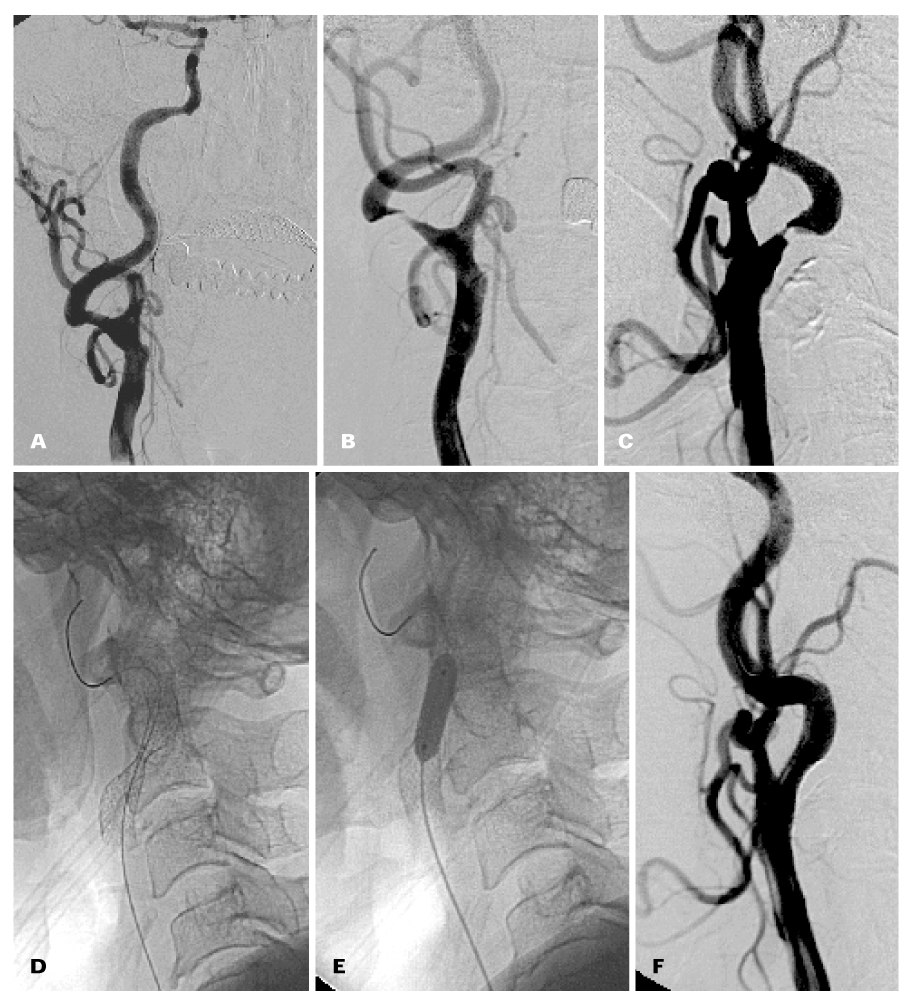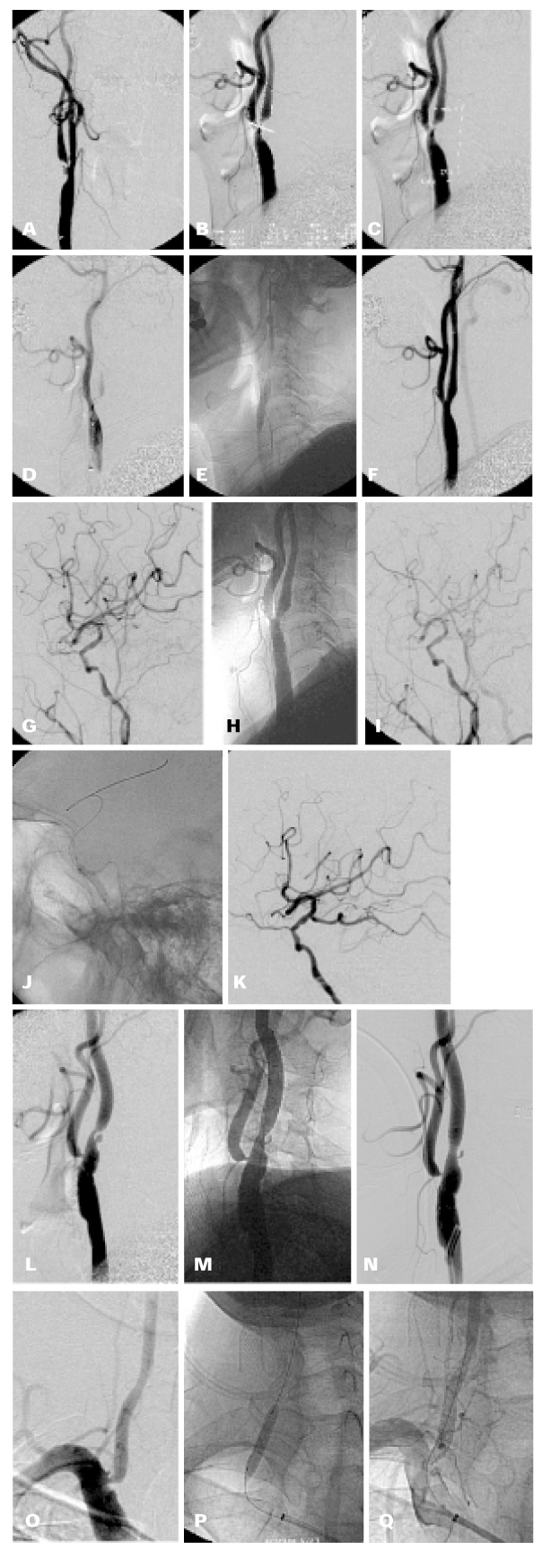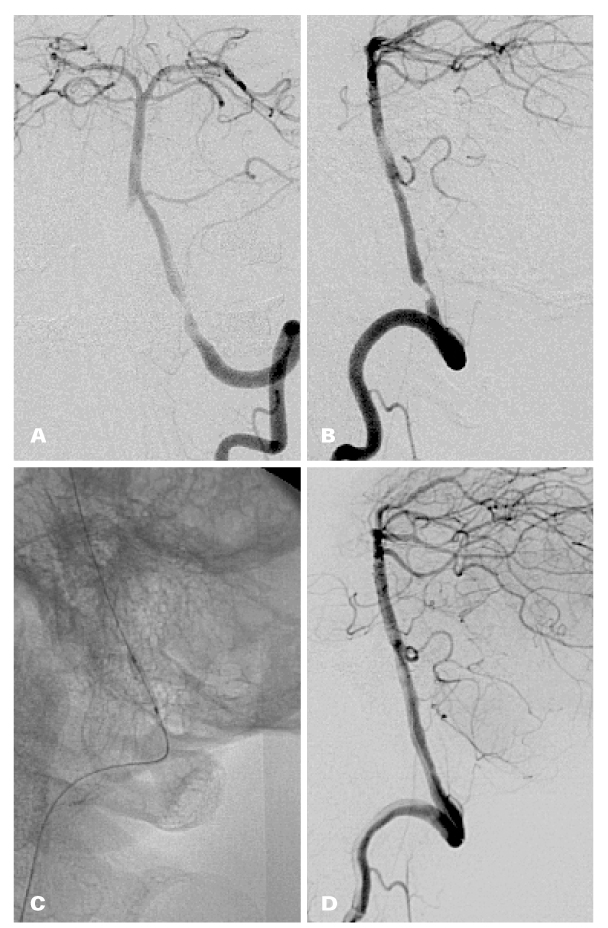 |
 |
- Search
| J Korean Med Assoc > Volume 47(7); 2004 > Article |
Abstract
Carotid atherosclerosis is one the main risk factors for ischemic stroke. Based on NASCET and ECST results, carotid endarterectomy is strongly recommended for severe symptomatic stenosis. However, in the past several years, carotid artery stenting has emerged as a potential therapeutic alternative to carotid endarterectomy. The main limitation of carotid stenting is the potential risk of thromboembolic complication. Recently, cerebral protection during carotid stenting is technically feasible and clinically safe. In the published data of prospective registry with cerebral protection, the incidence of periprocedural neurologic complications was lower than in registries without cerebral protection and similar to the best results reported for carotid endarterectomy. The future status of the endovascular approach will be determined by randomized trials directly comparing carotid artery stenting with cerebral protection and endarterectomy. Occlusive atherosclerotic disease involving the intracranial cerebral vessels can be managed medically with antiplatelet and anticoagulant drug therapy or surgically. However, in patients who are unresponsive to medical therapy or who have unacceptable surgical risks, percutaneous angioplasty with stenting is an attractive alternative that can be performed in selected patients with relatively low risk and good clinical outcome.
References
1. Korea National Statistical Office. Statistical Yearbook 2002.
2. The Korean Neurological Association. Epidemiology of Cerebrovascular diseases in Korea : a collaborative study, 1989-1990. J Korean Med Sci 1993;8:281-289.
3. Henrik Silesen. The natural history of patients with carotid stenosis. Pathophysiol Haemost Thromb 2002;32:378-380.
4. The North American Symptomatic Carotid Endarterectomy Trial Collaborators. Beneficial effect of carotid endarterectomy in symptomatic patients with high-grade carotid stenosis. N Engl J Med 1991;325:445-453.
5. The European Carotid Surgery Trialists' Collaborative Group. MRC European Carotid Surgery Trial : interim results for symptomatic patients with severe(70~99%) or with mild(0~29%) carotid stenosis. Lancet 1991;337:1235-1243.
6. Mayberg MR, Wilson SE, Yatsu F, Weiss DG, Messina L, Winn HR, et al. Carotid endarterectomy and prevention of cerebral ischemia in symptomatic carotid stenosis. Veterans Affairs Cooperative Studies Program 309 Trialist Group. JAMA 1991;266:3289-3294.
7. Crawley F, Clifton A, Buckenham T, Loosemore T, Taylor RS, Brown MM. Comparison of hemodynamic cerebral ischemia and microembolic signals detected during carotid endarterectomy and carotid angioplasty. Stroke 1997;28:2460-2464.
8. Orlandi G, Fanucchi S, Fioretti C, Acerbi G, Puglioli M, Murri L, et al. Characteristics of cerebral microembolism during carotid stenting and angioplasty alone. Arch Neurol 2001;58:1410-1413.
9. Theron JG, Payelle GG, Coskun O, Huet HF, Guimaraens L. Carotid artery stenosis : treatment with protected balloon angioplasty and stent placement. Radiology 1996;201:627-636.
10. Cremonesi A, Manetti R, Setacci F, Setacci C, Castriota F. Protected carotid stenting; clinical advantages and complications of embolic protection devices in 442 consecutive patients. Stroke 2003;34:1936-1943.
11. Endovascular versus surgical treatment in patients with carotid stenosis in the Carotid and Vertebral Artery Transluminal Angioplasty Study (CAVATAS) : a randomised trial. Lancet 2001;357:1729-1737.
12. Estes JM, Donaldson MC, Whittemore AD. Stenting for carotid stenosis? N Engl J Med 1997;337:427-428.
13. Yadav J. Stenting and Angioplasty with Protection in Patients at High Risk for Endarterectomy (SAPPHIRE) 2002;Chicago, Ill: American Heart Association.
14. Reimers B, Schluter M, Castriota F, Tubler T, Corvaja N, Colombo A, et al. Routine use of cerebral protection during carotid artery stenting : results of a multicenter registry of 753 patients. Am J Med 2004;116:217-222.
15. Roubin GS, New G, Iyer SS, Vitek JJ, Al-Mubarak N, Kuntz RE, et al. Immediate and late clinical outcomes of carotid artery stenting in patients with symptomatic and asymptomatic carotid artery stenosis : a 5-year prospective analysis. Circulation 2001;103:532-537.
16. Vitek J, Roubin G, Iyer S. Immediate and Late Outcome of Carotid Angioplasty with Stenting 1999;43:Nashville, Tenn: AANS/CNS/ASITN. 41.
17. Henry M, Amor M, Tzvetanov K, Chati Z. A new cerebral protection device for carotid angioplasty and stenting. First clinical experience with the Percusurge Guardwire. J Endovasc Surg 1999;6:321-331.
18. Meyers PM, Higashida RT, Phatouros CC, Malek AM, Lempert TE, Halbach VV, et al. Cerebral hyperperfusion syndrome after percutaneous transluminal stenting of the craniocervical arteries. Neurosurgery 2000;47:335-345.
19. Schoser BG, Heesen C, Eckert B, Thie A. Cerebral hyperperfusion injury after percutaneous transluminal angioplasty of extracranial arteries. J Neurol 1997;244:101-104.
20. The Warfarin-Aspirin Symptomatic Intracranial Disease (WASID) Trial Investigators. Design, progress and challenges of double-blind trial of warfarin versus aspirin for symptomatic intracranial arterial stenosis. Neuroepidemiology 2003;22:106-117.
21. Bogousslavsky J, Barnet HJM, Fox AJ, Hachinski VC, Taylor W. Atherosclerotic disease of the middle cerebral artery. Stroke 1986;13:1112-1120.
22. Craig DR, Meguro K, Watridge C, Robertson JT, Barnett HJ, Fox AJ. Intracranial internal carotid artery stenosis. Stroke 1982;13:825-828.
23. Chimowitz MI, Kokkinos J, Strong J, Brown MB, Levine SR, Furlan AJ, et al. The Warfarin-Aspirin Symptomatic Intracranial Disease Study. Neurology 1995;45:1488-1493.
24. Charturvedi S, Caplan LR. Angioplasty for intracranial atherosclerosis. Is the treatment worse than disease? Neurology 2003;61:1647-1648.
25. Lylyk P, Cohen JE, Ceratto R, Ferrario A, Mirranda C. Angioplasty and stent placement in intracranial atherosclerotic stenosis and dissections. AJNR 2002;23:430-436.
26. Connors JJ III, Wojak JC. Percutaneous transluminal angioplasty for intracranial atherosclerotic lesions : evolution of technique and short-term results. J Neurosurg 1999;91:415-423.
27. Marks MP, Marcellus M, Norbach AM, Steinberg GK, Tong D, Albers GW. Outcome of angioplasty for atherosclerotic intracranial stenosis. Stroke 1999;30:1065-1069.
- TOOLS
-
METRICS

-
- 1 Crossref
- Scopus
- 1,064 View
- 8 Download
-
Related articles in
J Korean Med Assoc -
Intratympanic injection for treatment of inner ear diseases2023 October;66(10)
Surgical treatment of senile spinal diseases2021 March;64(3)
Treatment of Ejaculatory Disorder1999 February;42(2)
Endoscopic Treatment of Stomach Cancer2002 February;45(2)
Prevention and Treatment of Vascular Dementia2002 April;45(4)








